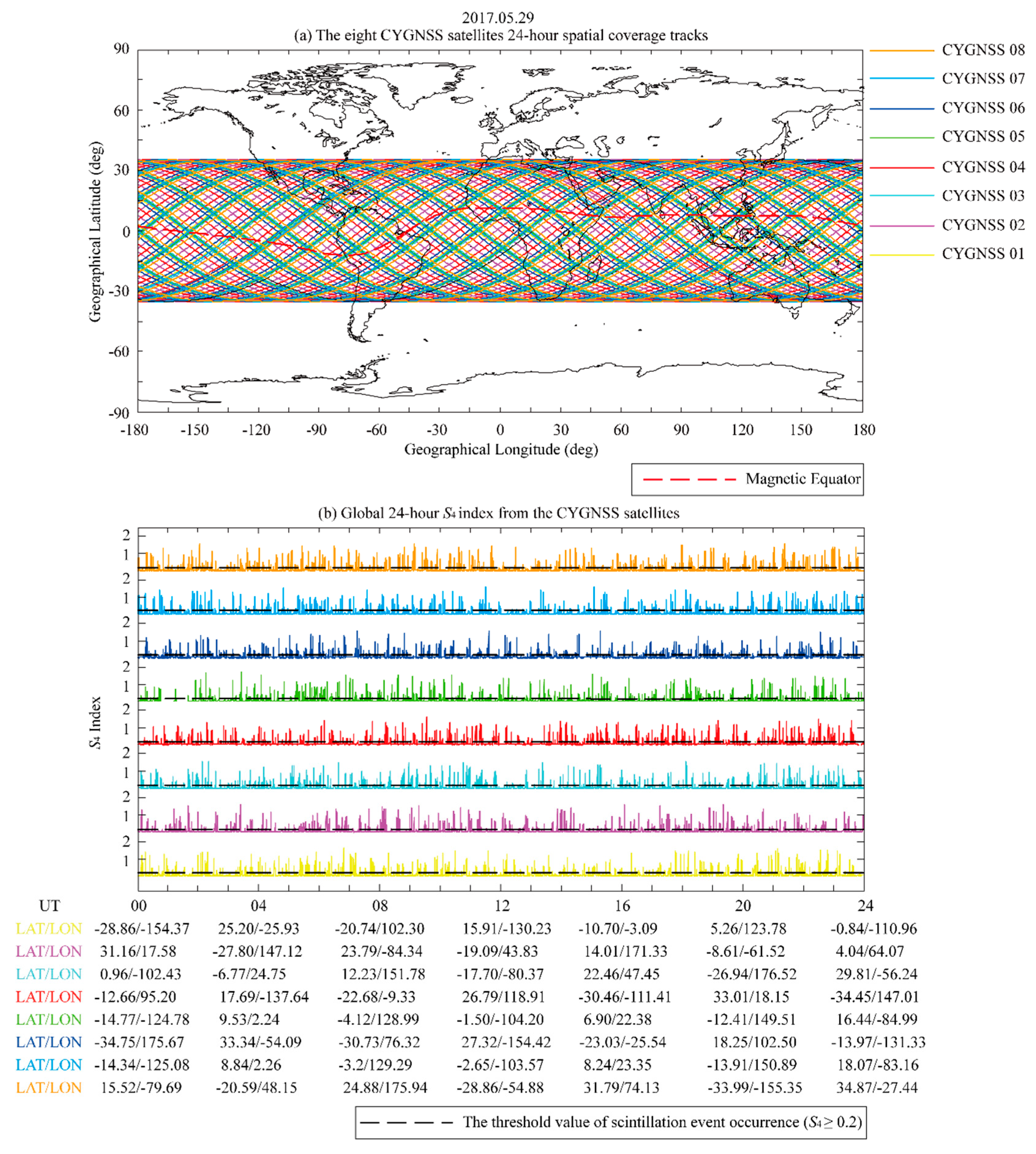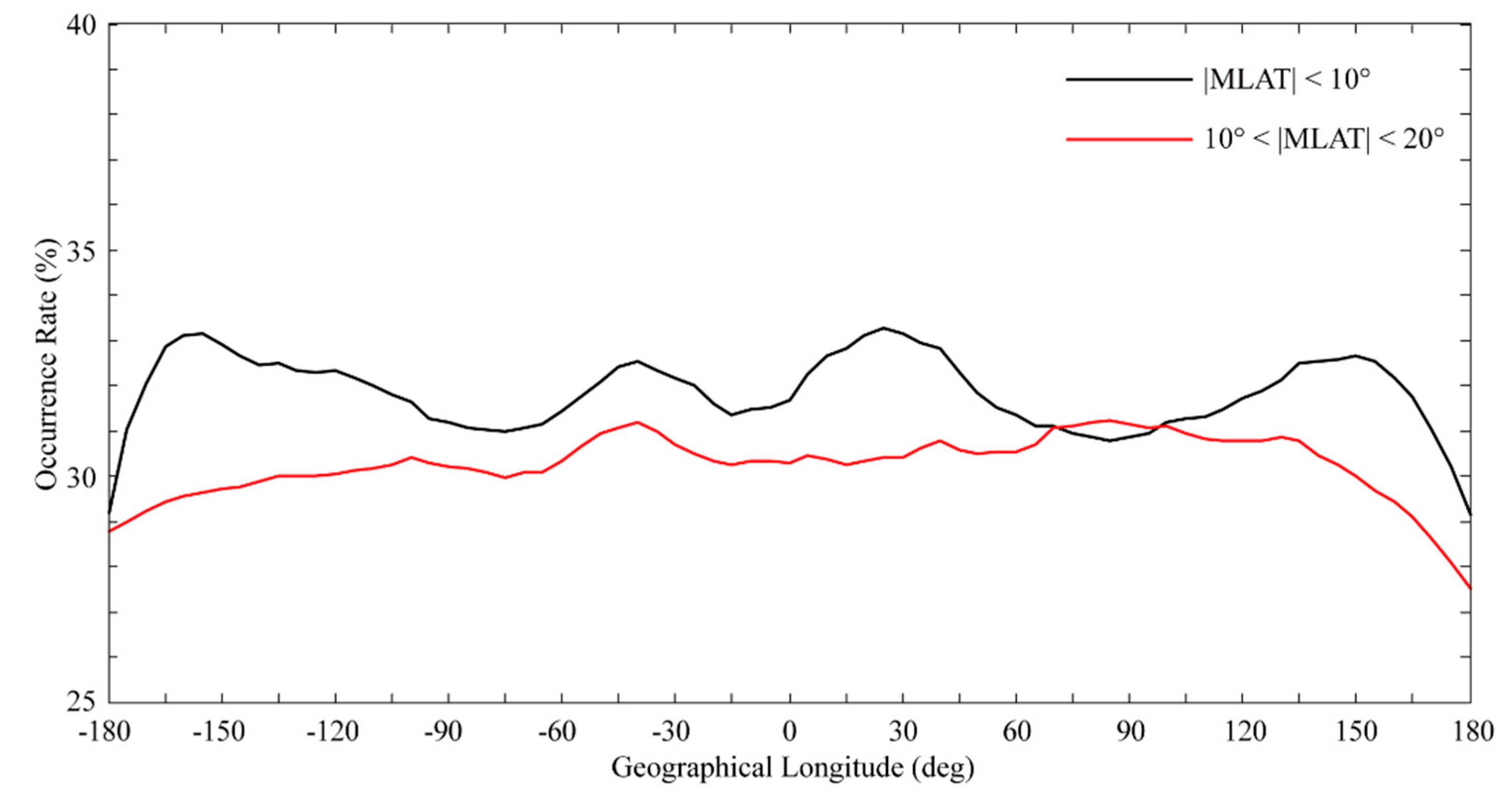Investigation of the Occurrence of Nighttime Topside Ionospheric Irregularities in Low-Latitude and Equatorial Regions Using CYGNSS Satellites
Abstract
1. Introduction
2. Instruments and Data
3. Results
4. Discussion
5. Conclusions
Author Contributions
Funding
Acknowledgments
Conflicts of Interest
References
- Basu, S.; Basu, S.; Khan, B.K. Model of equatorial scintillation from in-situ measurements. Radio Sci. 1976, 11, 821–832. [Google Scholar] [CrossRef]
- Woodman, R.F.; LaHoz, C. Radar observations of F region equatorial irregularities. J. Geophys. Res. 1976, 81, 5447–5466. [Google Scholar] [CrossRef]
- Woodman, R.F. Equatorial Ionospheric Irregularities as Observed by Jicamarca Radar, in Low-Latitude Ionospheric Physics. COSPAR Colloq. Ser.; Elsevier: Oxford, UK, 1993; Volume 7, pp. 83–95. [Google Scholar]
- Li, G.; Ning, B.; Liu, L.; Zhao, B.; Yue, X.; Su, S.; Venkatraman, S. Correlative study of plasma bubbles, evening equatorial ionization anomaly, and equatorial prereversal E × B drifts at solar maximum. Radio Sci. 2008, 43, RS4005. [Google Scholar] [CrossRef]
- Sidorova, L.N.; Filippov, S.V. Topside plasma bubbles, seen as He+ density depletions: seasonal/longitudinal occurrence probability. J. Atmos. Sol. Terr. Phys. 2012, 86, 83–91. [Google Scholar] [CrossRef]
- Kelly, M.C. The Earth’s Ionosphere: Plasma Physics and Electrodynamics (International Geophysics Series), 2nd ed.; Academic: San Diego, CA, USA, 2009. [Google Scholar]
- Oya, H.; Takahashi, T.; Watanabe, S. Observation of low latitude ionosphere by the impedance probe on board the Hinotori satellite. J. Geomag. Geoelectr. 1986, 38, 111–123. [Google Scholar] [CrossRef]
- Su, S.-Y.; Liu, C.H.; Ho, H.H.; Chao, C.K. Distribution characteristics of topside ionospheric density irregularities: Equatorial versus midlatitude region. J. Geophys. Res. 2006, 111, A06305. [Google Scholar] [CrossRef]
- Kil, H.; Heelis, R.A. Global distribution of density irregularities in the equatorial ionosphere. J. Geophys. Res. 1998, 103, 407–417. [Google Scholar] [CrossRef]
- Huang, C.Y.; Burke, W.J.; Machuzak, J.S.; Gentile, L.C.; Sultan, P.J. DMSP observations of equatorial plasma bubbles in the topside ionosphere near solar maximum. J. Geophys. Res. 2001, 106, 8131–8142. [Google Scholar] [CrossRef]
- Burke, W.J.; Gentile, L.C.; Huang, C.Y.; Valladares, C.E.; Su, S.-Y. Longitudinal variability of equatorial plasma bubbles observed by DMSP and ROCSAT. J. Geophys. Res. 2004, 109, A12301. [Google Scholar] [CrossRef]
- Burke, W.J.; Huang, C.Y.; Gentile, L.C.; Bauer, L. Seasonal longitudinal variability of equatorial bubble occurrence. Ann. Geophys. 2004, 22, 3089–3098. [Google Scholar] [CrossRef]
- Zakharenkova, I.; Astafyeva, E. Topside ionospheric irregularities as seen from multisatellite observations. J. Geophys. Res. Space Physics. 2015, 120, 807–824. [Google Scholar] [CrossRef]
- Dao, E.; Kelley, M.C.; Roddy, P.; Retterer, J.; Ballenthin, J.O.; de La Beaujardiere, O.; Su, Y.-J. Longitudinal and seasonal dependence of nighttime equatorial plasma density irregularities during solar minimum detected on the C/NOFS satellite. Geophys. Res. Lett. 2011, 38, L10104. [Google Scholar] [CrossRef]
- Kil, H.; Kwak, Y.-S.; Lee, W.K.; Krall, J.; Huba, J.D.; Oh, S.-J. Nonmigrating tidal signature in the distributions of equatorial plasma bubbles and prereversal enhancement. J. Geophys. Res. Space Physics 2015, 120, 3254–3264. [Google Scholar] [CrossRef]
- Sidorova, L.N.; Filippov, S.V. Equatorial Plasma Bubbles: Effect of Thermospheric Winds Modulated by DE3 Tidal Waves. Geomagn. Aeronomy 2018, 58, 214–222. [Google Scholar] [CrossRef]
- Sidorova, L.N.; Filippov, S.V. Four-peak longitudinal distribution of the equatorial plasma bubbles observed in the topside ionosphere: Possible troposphere tide influence. Adv. Space Res. 2018, 61, 1412–1424. [Google Scholar] [CrossRef]
- Heise, S.; Jakowski, N.; Wehrenpfenning, A.; Reigber, C.; Lühr, H. Sounding of the topside ionosphere/plasmasphere based on GPS measurements from CHAMP: Initial results. Geophys. Res. Lett. 2002, 29, 1699. [Google Scholar] [CrossRef]
- Ruf, C.S.; Atlas, R.; Chang, P.S.; Clarizia, M.P.; Garrison, J.L.; Gleason, S.; Katzberg, S.J.; Jelenak, Z.; Johnson, J.T.; Majumdar, S.J.; et al. New Ocean Winds Satellite Mission to Probe Hurricanes and Tropical Convection. Bull. Am. Meteor. Soc. 2016, 97, 385–395. [Google Scholar] [CrossRef]
- Clarizia, M.P.; Ruf, C.S. Wind Speed Retrieval Algorithm for the Cyclone Global Navigation Satellite System (CYGNSS) Mission. IEEE Trans. Geosci. Remote Sens. 2016, 54, 4419–4435. [Google Scholar] [CrossRef]
- Aarons, J. Global morphology of ionospheric scintillations. Proc. IEEE 1982, 70, 60–378. [Google Scholar] [CrossRef]
- Brahmanandam, P.S.; Uma, G.; Liu, J.Y.; Chu, Y.H.; Latha Devi, N.S.M.P.; Kakinami, Y. Global S4 index variations observed using FORMOSAT-3/COSMIC GPS RO technique during a solar minimum year. J. Geophys. Res. 2012, 117, A09322. [Google Scholar] [CrossRef]
- Dungey, J.W. Convective diffusion in the equatorial F-region. J. Atmos. Terr. Phys. 1956, 9, 304–310. [Google Scholar] [CrossRef]
- Farley, D.T.; Balsley, B.B.; Woodman, R.F.; McClure, J.P. Equatorial spread F: Implications of VHF radar observations. J. Geophys. Res. 1970, 75, 7199–7216. [Google Scholar] [CrossRef]
- Sultan, P.J. Linear theory and modeling of the Rayleigh-Taylor instability leading to the occurrence of equatorial spread F. J. Geophys. Res. 1996, 101, 26875–26892. [Google Scholar] [CrossRef]
- Tsunoda, R.T. Control of the seasonal and longitudinal occurrence of equatorial scintillations by the longitudinal gradient in integrated E region Pedersen conductivity. J. Geophys. Res. 1985, 90, 447–456. [Google Scholar] [CrossRef]
- Otsuka, Y.; Shiokawa, K.; Ogawa, T. Equatorial ionospheric scintillations and zonal irregularity drifts observed with closely-spaced GPS receivers in Indonesia. J. Meteor. Soc. Jpn. 2006, 84A, 343–351. [Google Scholar] [CrossRef]
- Dymond, K.F. Global observations of L band scintillation at solar minimum made by COSMIC. Radio Sci. 2012, 47, RS0L18. [Google Scholar] [CrossRef]
- Maruyama, T.; Saito, S.; Kawamura, M.; Nozaki, K.; Krall, J.; Huba, J.D. Equinoctial asymmetry of a low-latitude ionosphere-thermosphere system. Ann. Geophys. 2009, 27, 2027–2034. [Google Scholar] [CrossRef]
- Maruyama, T.; Matuura, N. Longitudinal variability of annual changes in activity of equatorial spread F and plasma bubbles. J. Geophys. Res. 1984, 89, 10903–10912. [Google Scholar] [CrossRef]
- Ren, Z.; Wan, W.; Liu, L.; Chen, Y.; Le, H. Equinoctial asymmetry of ionospheric vertical plasma drifts and its effect on F region plasma density. J. Geophys. Res. 2011, 116, A02308. [Google Scholar] [CrossRef]
- Sripathi, S.; Kakad, B.; Bhattacharyya, A. Study of equinoctial asymmetry in the equatorial spread F (ESF) irregularities over Indian region using multi-instrument observations in the descending phase of solar cycle 23. J. Geophys. Res. 2011, 116, A11302. [Google Scholar] [CrossRef]
- Juan, J.M.; Sanz, J.; Garcia, A.R.; Casado, G.G.; Ibáñez, D.; Perez, R.O. AATR an ionospheric activity indicator specifically based on GNSS measurements. J. Space Weather Space Clim. 2018, 8, 1–11. [Google Scholar] [CrossRef]
- Chen, S.P.; Bilitza, D.; Liu, J.Y.; Caton, R.; Chang, L.C.; Yeh, W.H. An empirical model of L-band scintillation S4 index constructed by using FORMOSAT-3/COSMIC data. Adv. Space Res. 2017, 60, 1015–1028. [Google Scholar] [CrossRef]
- Hysell, D.L.; Burcham, J.D. Long term studies of equatorial spread F using the JULIA radar at Jicamarca. J. Atmos. Sol. Terr. Phys. 2002, 64, 1531–1543. [Google Scholar] [CrossRef]
- McClure, J.P.; Singh, S.; Bamgboye, D.K.; Johnson, F.S.; Kil, H. Occurrence of equatorial F region irregularities: Evidence for tropospheric seeding. J. Geophys. Res. 1998, 103, 29119–29135. [Google Scholar] [CrossRef]
- Kil, H.; Oh, S.-J.; Paxton, L.J.; Fang, T.-W. High-resolution vertical ExB drift model derived from ROCSAT-1 data. J. Geophys. Res. 2009, 114, A10314. [Google Scholar] [CrossRef]
- Rottger, J. Traveling disturbances in the equatorial ionospheric spread F and their association with penetrative cumulus convection. J. Atmos. Terr. Phys. 1977, 39, 987–998. [Google Scholar] [CrossRef]
- Rottger, J. Equatorial spread F by electric fields and atmospheric gravity waves generated by thunderstorms. J. Atmos. Terr. Phys. 1981, 43, 453–462. [Google Scholar] [CrossRef]
- Hysell, D.L.; Kudeki, E. Collisional shear instability in the equatorial F-region ionosphere. J. Geophys. Res. 2004, 109, A11301. [Google Scholar] [CrossRef]
- Kudeki, E.; Bhattacharyya, S. Postsunset vortex in equatorial F-region plasma drifts and implications for bottomside spread-F. J. Geophys. Res. 1999, 104, 28163–28170. [Google Scholar] [CrossRef]
- Kudeki, E.; Akgiray, A.; Milla, M.A.; Chau, J.L.; Hysell, D.L. Equatorial spread-F initiation: post-sunset vortex, thermospheric winds, gravity waves. J. Atmos. Sol. Terr. Phys. 2007, 69, 2416–2427. [Google Scholar] [CrossRef]





© 2020 by the authors. Licensee MDPI, Basel, Switzerland. This article is an open access article distributed under the terms and conditions of the Creative Commons Attribution (CC BY) license (http://creativecommons.org/licenses/by/4.0/).
Share and Cite
Huang, L.; Liu, Y.; Tang, Q.; Chen, G.; Wang, Z.; Zhou, C. Investigation of the Occurrence of Nighttime Topside Ionospheric Irregularities in Low-Latitude and Equatorial Regions Using CYGNSS Satellites. Sensors 2020, 20, 708. https://doi.org/10.3390/s20030708
Huang L, Liu Y, Tang Q, Chen G, Wang Z, Zhou C. Investigation of the Occurrence of Nighttime Topside Ionospheric Irregularities in Low-Latitude and Equatorial Regions Using CYGNSS Satellites. Sensors. 2020; 20(3):708. https://doi.org/10.3390/s20030708
Chicago/Turabian StyleHuang, Liang, Yi Liu, Qiong Tang, Guanyi Chen, Zhuangkai Wang, and Chen Zhou. 2020. "Investigation of the Occurrence of Nighttime Topside Ionospheric Irregularities in Low-Latitude and Equatorial Regions Using CYGNSS Satellites" Sensors 20, no. 3: 708. https://doi.org/10.3390/s20030708
APA StyleHuang, L., Liu, Y., Tang, Q., Chen, G., Wang, Z., & Zhou, C. (2020). Investigation of the Occurrence of Nighttime Topside Ionospheric Irregularities in Low-Latitude and Equatorial Regions Using CYGNSS Satellites. Sensors, 20(3), 708. https://doi.org/10.3390/s20030708






